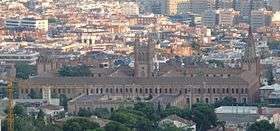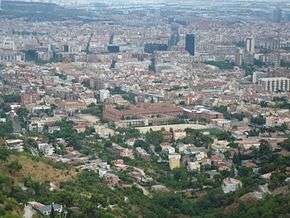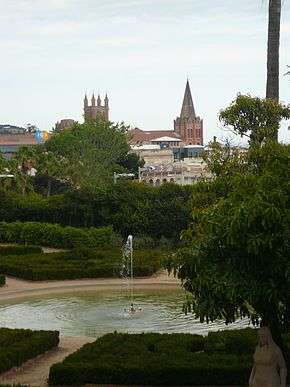St. Ignatius College, Barcelona
| St. Ignatius College, Barcelona Jesuïtes Sarrià-Sant Ignasi | |
|---|---|
 | |
| Address | |
|
Carrasco i Formiguera 32 Barcelona | |
| Coordinates | 41°24′12″N 2°07′16″E / 41.403467°N 2.121133°ECoordinates: 41°24′12″N 2°07′16″E / 41.403467°N 2.121133°E |
| Information | |
| Type | Jesuit, Catholic |
| Established | 1892 |
| Gender | Coeducational |
| Enrollment | 3,000 |
| Website | IgnacioBarcelona |
 | |



St. Ignatius College, Barcelona (Jesuïtes Sarrià-Sant Ignasi) belongs to the Catalan Jesuit network of schools.[1] It was founded in 1892 and is located in the Sarrià neighborhood of Barcelona. It purposes to train people capable of contributing to make society more open, fair, and inclusive, through fidelity to human, social and Christian values.
Jesuïtes Sarrià-Sant Ignasi currently offers kindergarten, primary, secondary high school, and vocational training; the compulsory part is government subsidized. The school strives to be innovative with an institutional climate of trust, responsibility, and freedom, facilitating the capacity for critical analysis and reflection to help students to be open to the challenges of each historical moment.[2]
The main building, designed by Joan Martorell, is two neo-Gothic towers, baked brick facades, and windows with pointed arches. The annexes do not follow this architectural style but are based on concrete and functionality.
History
The center began as a boarding school in a rented municipal building in Manresa, which was evacuated after a misunderstanding between the Council and the Jesuits.
In 1892 the Jesuits bought the Gardeny property, consisting of a house and extensive gardens. An annex was built and classes began the same year. The current building was built between 1893 and 1896, and opened in 1895 unfinished (completed between 1915 and 1926). It was originally a boarding school but began admitting external students in 1905. In 1907 it had 20 teachers and 230 students, mostly boarders.
The school was closed in 1914 so that the facility could accommodate the Jesuit houses of philosophical and theological studies for the priesthood, but it reopened in 1927. Seven and nine-year programs were offered. Boarders now were in the minority.
During the Second Republic as a result of the decree of expulsion of the Jesuits, the Government made it a public school until the end of the Civil War. As a replacement the Jesuits opened the Academy Ramon Llull, which was also seized at the start of the Civil War. They then opened yet another, Margenat Academy.
After 1939 the school was returned to the Jesuits and began to operate normally. The building has since been used exclusively as a school. The trauma of the Civil War (the largest Spain experienced, with opposing ideals) was followed by a quiet period of economic growth. The enrollment was high in 1949, with a steady growth in students.[3] The school currently has about 3,000 students. Secondary education in Spain depends largely on religious congregations.
For the Barcelona Olympics (1992) an International Youth Camp was built. The sports and recreation center was remodeled, furnishing an athletics track, swimming pool, and gym to accommodate the participants in those events.
Prominent alumni
Politics
Resources
- García Gargallo, Manuel. Communities of men. The teaching of the Church in the city of Barcelona. Statistical Directory (in Catalan). University of Barcelona (dissertation), 2002. ISBN 846-89835-43.
- Yetano, Ana. The religious educational institution in the Spain of the Restoration (1900-1920). Anthropos Editorial, 1 January 1988, p. 216-. ISBN 978-84-7658-062-2.
- Sarrià photos
References
- ↑ "Jesuïtes Educació | Jesuïtes Catalunya". www.jesuites.net. Retrieved 2017-01-07.
- ↑ Administrador. "Jesuïtes Sarrià-Sant Ignasi (Barcelona)". www.educacionjesuitas.es. Retrieved 2017-01-07.
- ↑ García Gargallo, Manuel. Communities of men. The teaching of the Church in the city of Barcelona. Statistical Directory (in Catalan). University of Barcelona (dissertation), 2002. ISBN 846-89835-43
- ↑ Márquez, Daniel Carlos "Drip voters in uptown Barcelona" El Periódico, 11 September 2014 [Question: 22 October 2016
External links
| Wikimedia Commons has media related to St. Ignatius College, Barcelona. |